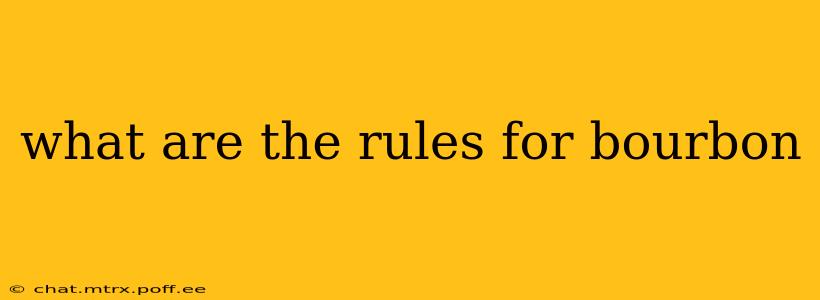Bourbon whiskey, a spirit synonymous with American heritage and tradition, isn't just any whiskey. It's governed by a strict set of regulations that define its unique character and quality. Understanding these rules is key to appreciating the nuances of this beloved drink. Let's delve into the specifics of what makes a bourbon a bourbon.
What Makes a Whiskey a Bourbon? The Essential Requirements
The defining characteristics of bourbon are enshrined in U.S. law, specifically Title 27, Chapter 1, Subchapter A, Part 5 of the Code of Federal Regulations (CFR). These rules ensure consistency and quality across all bourbons, no matter the producer. Here are the key requirements:
-
Grain Bill: At least 51% corn must be used in the mash bill (the mixture of grains used to make the whiskey). This corn provides bourbon's signature sweetness. The remaining percentage can include other grains like rye, wheat, or barley. The specific mix of grains significantly impacts the flavor profile of the bourbon.
-
New, Charred Oak Barrels: Bourbon must be aged in new, charred oak barrels. This process is crucial for the development of bourbon's complex flavor and color. The charring caramelizes sugars in the wood, imparting vanillin (vanilla flavor) and other desirable compounds. The use of new barrels, rather than used ones, is a defining characteristic.
-
Distillation: The distilled mash must have an alcohol content (proof) no higher than 160 proof (80% alcohol by volume).
-
Bottling: Bourbon must be bottled at a proof of not less than 80 proof (40% alcohol by volume).
-
Made in the U.S.: As with many other spirits, this is a key criterion. It must be produced in the United States.
Beyond the Basics: Understanding Different Bourbon Styles
While the rules above define the minimum requirements, many variations exist within the bourbon category. These variations arise from differences in the grain bill, the level of char on the barrels, and the aging process. Here are some examples:
-
High-Rye Bourbon: These bourbons use a higher percentage of rye in the mash bill, resulting in spicier and drier flavor profiles.
-
Wheat Bourbon: Wheat bourbons use wheat as the secondary grain, creating smoother, sweeter bourbons with less spice.
-
Straight Bourbon: This designation means the bourbon has been aged for at least two years in new, charred oak barrels and contains no added flavorings.
-
Small Batch Bourbon: While not officially regulated, this term typically refers to bourbon made from a small number of barrels, often resulting in more nuanced and consistent flavor.
What are the Different Types of Bourbon?
This question is often asked alongside the core regulations. The answer lies in the nuances of production and marketing. As detailed above, "Straight Bourbon" is a key designation, indicating a minimum of two years aging in new, charred oak barrels and no additives. Beyond that, there isn't an official categorization beyond the legal requirements. Terms like "Small Batch" and "Single Barrel" are marketing terms, suggesting a particular production method rather than strict legal classifications.
How Long Does Bourbon Age?
The minimum aging requirement for straight bourbon is two years. However, many bourbons are aged for much longer, often resulting in more complex and mellow flavors. The length of aging is a significant factor influencing a bourbon's character.
What is the Difference Between Bourbon and Rye?
The key difference lies in the grain bill. Bourbon must be at least 51% corn, while rye whiskey must be at least 51% rye. This difference in the primary grain leads to distinctly different flavor profiles – bourbon tends to be sweeter, while rye is often spicier and drier.
Understanding these rules and the nuances within them provides a deeper appreciation for the complexity and diversity of the world of bourbon. From the simplest to the most complex expressions, each bottle tells a story of American craftsmanship and tradition.
